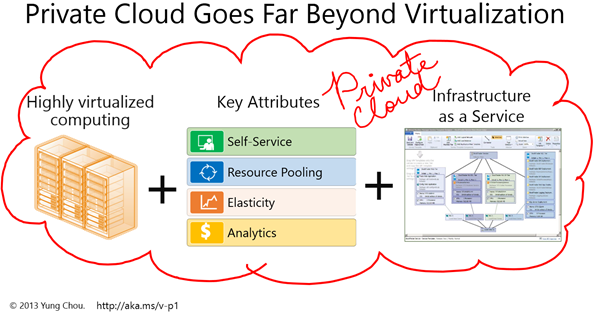Build Your Private Cloud Series: Why Private Cloud by Yung Chou
Although this is not necessarily a super technical article, it is an important one. With everyone (including Microsoft) throwing around the term “Private Cloud”, it is important to understand what it is and why you would want one. Otherwise, why would you spend time building one??
In this part, Yung Chou explains what a Private Cloud is (it’s not virtualization). I am including a brief snippet from Yung’s article. To read the full article, please go directly to Yung’s Blog Post.
Some IT decision makers may wonder, I have already virtualized my datacenter and am running a highly virtualized IT environment, do I still need a private cloud? If so, why?
The answer is a definitive YES, and the reason is straightforward. The plain truth is that virtualization is no private cloud, and a private cloud goes far beyond virtualization. (Ref 1, Ref 2)
Virtualization Is No Private Cloud
Technically, virtualization is signified by the concept of “isolation.” By which a running instance is isolated in a target runtime environment with the notion that the instance consumes the entire runtime environment despite the fact that multiple instances may be running at the same time with the same hosting environment. A well understood example is server virtualization where multiple server instances running on the same hardware while each instance runs as if it possesses the entire runtime environment provided by the host machine.
A private cloud on the other hand is a cloud which abides the 5-3-2 Principle or NIST SP 800-145, the de facto definition of cloud computing. In other words, a private cloud as illustrated above must exhibit the attributes like elasticity, resource pooling, self-service model, etc. of cloud computing and be delivered in a particular fashion. Virtualization nonetheless does not hold, for instance, any of the three attributes as a technical requirement. Virtualization is about isolating and virtualizing resources, while how a virtualized resource is allocated, delivered, or presented is not particularly specified. At the same time, cloud computing or a private cloud, is visualized much differently. The accessibility, readiness, and elasticity of all consumable resources in cloud computing are conceptually defined and technically required for being delivered as “services.”
Essence of Cloud Computing
The service concept is a center piece of cloud computing. A cloud resource is to be consumed as a service. This is why these terms, IaaS, PaaS, SaaS, ITaaS, and XaaS (everything and anything as a service), are frequently heard in a cloud discussion. A service is what must be presented to and experienced by a cloud user. So, what is a service?
A service can be presented and implemented in various ways like forming a web service with a block of code, for example. However in the context of cloud computing, a service can be precisely captured by three words, capacity on demand. Capacity here is associated with an examined object such as cpu, network connections, or storage. One-demand denotes the anytime readiness with any network and any device accessibility. It is a state that previously takes years and years of IT disciplines and best practices to possibly achieve with a traditional infrastructure-focused approach, while cloud computing makes “service” a basic deliver model and demand all consumable resources including infrastructure, platform, and software to be presented as services. Consequently, replacing the term, service, with “capacity of demand” or simply “on demand’ brings clarity and gives substance to any discussion of cloud computing.
- See more at: https://blogs.technet.com/b/yungchou/archive/2013/04/02/why-private-cloud.aspx#sthash.jgWMArDq.dpuf
…
Harold Wong
